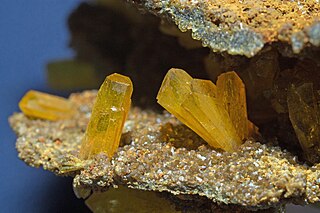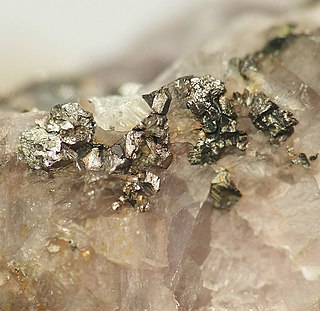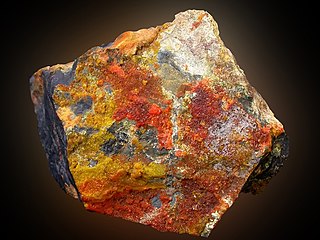
Spa is a city and municipality of Wallonia in the province of Liège, Belgium, whose name became an eponym for mineral baths with supposed curative properties. It is in a valley in the Ardennes mountains 35 km (22 mi) south-east of Liège and 45 km (28 mi) south-west of Aachen. In 2006, Spa had a population of 10,543 and an area of 39.85 km2 (15.39 sq mi), giving a population density of 265/km2 (690/sq mi).

Hemimorphite is the chemical compound Zn4(Si2O7)(OH)2·H2O, a component of mineral calamine. It is a silicate mineral which, together with smithsonite (ZnCO3), has been historically mined from the upper parts of zinc and lead ores. Both compounds were originally believed to be the same mineral and classified as calamine. In the second half of the 18th century, it was discovered that these two different compounds were both present in calamine. They closely resemble one another.

Germanite is a rare copper iron germanium sulfide mineral, Cu26Fe4Ge4S32. It was first discovered in 1922, and named for its germanium content. It is only a minor source of this important semiconductor element, which is mainly derived from the processing of the zinc sulfide mineral sphalerite. Germanite contains gallium, zinc, molybdenum, arsenic, and vanadium as impurities.

Pyrophyllite is a phyllosilicate mineral composed of aluminium silicate hydroxide: Al2Si4O10(OH)2. It occurs in two forms (habits): crystalline folia and compact masses; distinct crystals are not known.

The Union Minière du Haut-Katanga was a Belgian mining company which controlled and operated the mining industry in the copperbelt region in the modern-day Democratic Republic of the Congo between 1906 and 1966.

Hopeite is a hydrated zinc phosphate with formula: Zn3(PO4)2·4H2O. It is a rare mineral used mainly as a collectors specimen.

Fraipontite is a zinc aluminium silicate mineral with a formula of (Zn,Al)3(Si,Al)2O5(OH)4.

Legrandite is a rare zinc arsenate mineral, Zn2(AsO4)(OH)·(H2O).

Vaesite (NiS2) is a mineral found together with cattierite in the Democratic Republic of Congo. It is named after Johannes F. Vaes, a Belgian mineralogist. It is part of the pyrite group.

Kipushi is a town in Haut-Katanga province, Democratic Republic of the Congo. It lies 35 km southwest of the city of Lubumbashi, very close to the border with Zambia, at an altitude of 1329 m (4363 ft). The main economic activity of the town is mining. Kipushi is part of the Roman Catholic Diocese of Sakania–Kipushi.

Vantasselite is a rare aluminium phosphate mineral with formula: Al4(PO4)3(OH)3 •9H2O. It crystallizes in the orthorhombic system and has a white color, a hardness of 2 to 2.5, a white streak and a pearly luster.

Masuyite is a uranium/lead oxide mineral with formula Pb[(UO2)3O3(OH)2]·3H2O.

Cattierite (CoS2) is a cobalt sulfide mineral found in the Democratic Republic of Congo. It was discovered together with the nickel sulfide vaesite by Johannes F. Vaes, a Belgian mineralogist and named after Felicien Cattier, who was chairman of the board of the Union Minière du Haut-Katanga.

Dundasite is a rare lead aluminium carbonate mineral. The mineral is named after the type locality, Dundas, Tasmania, Australia. The mineral was first discovered in the Adelaide Proprietary Mine. Dundasite was first described by William Frederick Petterd in 1893.

Cuprosklodowskite is a secondary uranium mineral formed by alteration of earlier uranium minerals. Its empirical formula is Cu(UO2)2(HSiO4)2·6(H2O). Cuprosklodowskite is a nesosilicate mineral, It is grass green to dark green in color, and its crystal habit is typically acicular, flat bladed crystals. It is a strongly radioactive mineral.

Demesmaekerite is a rare uranium selenite mineral with the chemical formula: Pb2Cu5(UO2)2(SeO3)6(OH)6·2H2O.

Hemusite (IMA symbol: Hm) is a very rare isometric gray mineral containing copper, molybdenum, sulfur, and tin with chemical formula Cu6SnMoS8. It was discovered by Bulgarian mineralogist Georgi Ivanov Terziev in 1963. He also described it and named it after Haemus, the ancient name of Stara planina (Balkan) mountains in Europe. The type locality is Chelopech copper ore deposit, Bulgaria. Later tiny deposits of hemusite were found in Ozernovskoe deposit, Kamchatka, Russia; Kawazu mine, Rendaiji, Shimoda city, Chūbu region, Honshu Island, Japan; Iriki mine, Iriki, Satsuma-gun, Kagoshima Prefecture, Kyushu Region, Japan; Kochbulak deposit, Tashkent, Uzbekistan. Hemusite occurs as rounded isometric grains and aggregates usually about 0.05 mm in diameter and in association with enargite, luzonite, colusite, stannoidite, renierite, tennantite, chalcopyrite, pyrite, and other minerals.

Fourmarierite is a secondary uranium-lead mineral. It was named for the Belgian geologist Paul Fourmarier (1877–1970). Its chemical formula is Pb(UO
2)
4O
3(OH)
4•4H
2O.

Teineite is a tellurite mineral with the formula Cu(TeO3). 2 H2O. It has a Mohs hardness of 2.5 and it comes in many different shades of blue, ranging from cerulean blue to bluish-gray. The mineral millsite has the same chemical composition, but crystallizes in the monoclinic system, while teineite crystallizes in the orthorhombic system.



















